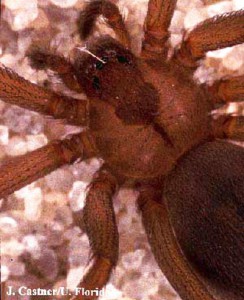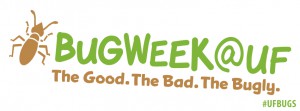That depends on your definition of ‘here.’ No breeding populations of any species of recluse spiders (Loxosceles laeta, Loxosceles reclusa, and Loxosceles rufescens have all been found in the state), has been found in any Florida county in a native habitat. A few verified samples (about 20) have turned up in Florida, but all records are from buildings or vehicles. These typically are brought in by travelers from Midwestern or Mideastern states (the brown recluse, Loxosceles reclusa), cargo shipped to warehouses that was brought in from other states or Europe (the Mediterranean recluse, Loxosceles rufescens), or international shipments from tropical America (the Chilean recluse, L. laeta). By the way, this is a good time to point out that it’s unwise to transport firewood, live plants and other plant materials from one state to another, because you may accidentally transport brown recluse spiders and various pest arthropods.
Here’s our take on the question “why do so many people in Florida THINK they see brown recluse spiders?” The brown recluse is a rather plain-looking spider, especially to the casual observer. It’s brown or yellowish brown with dark brown marks, adults have a leg span about the size of a quarter to a half-dollar, and isn’t usually seen in a web.
Figure 1. Detail of the carapace of the brown recluse spider, Loxosceles reclusa Gertsch and Mulaik, showing the dark fiddle-shaped marking often used to identify this spider. Photograph by James L. Castner, University of Florida.
There are other spiders found in Florida that share some characteristics with the brown recluse – the same approximate size and color, similar habits. Here’s one example — Kukulcania hibernalis, the southern house spider, aka crevice spider, aka that brown, hairless-looking spider that comes charging out of your car’s doorframe or windshield wipers when you try to drive to work in the morning. The lighter colored males are especially superficially similar to a recluse spider in appearance.
So it is not unreasonable for a person to err on the side of caution and assume that any medium-sized brown spider in a dark, quiet place could be a brown recluse and leave it alone. The first thing to do once you get a good look at it is to compare what you saw to an online information source. Remember that it is unlikely that you will find a recluse spider in Florida. However, if you have compared your spider to the online pictures, anyone who still truly believes that he or she has found a genuine brown recluse in Florida should contact Dr. G.B. Edwards with FDACS-DPI. Please attach a good digital image of the top of the spider for identification.
Also, you can read more about venomous spiders in this Pest Alert from the Florida Department of Agriculture and Consumer Services.
For more BugWeek information and activities, visit the website.
If you have questions that weren’t answered by the FAQ, contact us or contact your local Extension office.
 0
0


